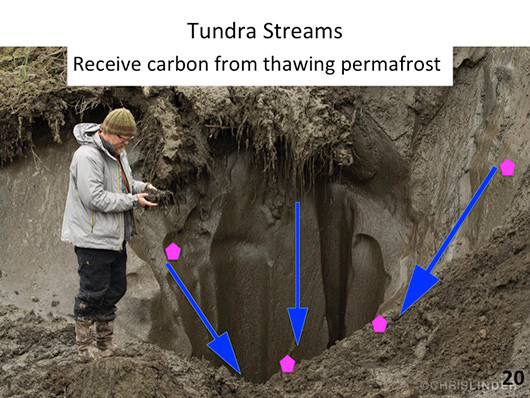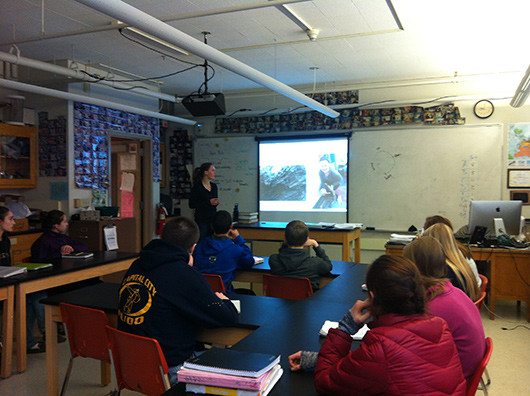I couldn’t believe it was me, but there I was, talking at American Chemical Society (ACS) session on Modern Analytical Approaches for the Characterization of Natural Organic Matter in the Environment. I went through my slides, discussed my results, got a laugh with my picture of John Schade next to a giant ice wedge in permafrost that I referred to as “my coauthor for scale,” and handled the many questions that I received.

Slide from my ACS talk showing thawing permafrost at Duvannyi Yar (photo © Chris Linder).
Even as questions opened my eyes to potential weaknesses in my project design, they also confirmed that the story I had begun uncovering was engaging. As I walked back to my seat after my 25 minutes on stage, Dr. George Aiken (one of the session chairs and a master of dissolved organic carbon chemistry) gave me a thumbs up. I collapsed with relief into my seat.

Talking to kids at Juneau-Douglas High School.
The only other talk I had given about my work was for students in the high school classroom I grew up in—an amazing chance to spread my new knowledge of arctic science to kids from my hometown. I enjoyed teaching them about the general subject of arctic science, and found it a good challenge to explain DOC to people who had never had a chemistry class.
As far as I know, I am the first Polaris participant to bring work from the Kolyma to an ACS meeting. I was certainly the only undergraduate in the ACS session. After the morning session ended, fellow attendees offered suggestions and help with future analysis of the permafrost DOC samples I hope to analyze when I return to Siberia this summer. Others wanted to talk to me about graduate school positions with them.
I learned so much from talking to these chemists and hearing their talks. It was a crash course in DOC chemistry, and an overview of the many tools available to study it. I am a chemist by training, but I have been working with people who think more about the big picture than about bond structures. This meeting forced me to make deeper connections between the ecological implications of my study and the chemistry that underlies it, and strengthened my resolve to turn my work from last and next summer into a manuscript and eventually into a paper. After all, if I can manage my fear and present at ACS to research chemists, anything is possible.




Comments(2)-
-
john leake says
June 1, 2015 at 6:59 pmIn preparing for a return assignment do you hypothesize changes you may find to an environment you are now somewhat familiar with?
Megan Behnke says
July 5, 2015 at 3:17 amThis summer I have the chance to shift my focus from the dissolved carbon already in the tundra streams to the dissolved carbon emerging out of freshly thawing permafrost, and with this opportunity comes a new environment with new exciting questions to explore. Therefore, though I am now more familiar with the behavior of carbon once it enters streams, I get to investigate a new area for me–it’s behavior when it first thaws. The knowledge I gained last summer–both about light-carbon interactions and about how to plan, organize, and conduct research in this remote spot–is definitely easing my work this summer!